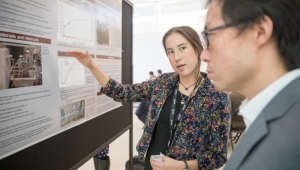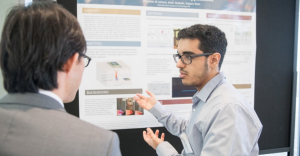
Undergraduate research was a highlight of the MIT Energy Initiative (MITEI) Annual Research Conference for the first time in December 2017, as 15 students presented posters of energy-related work in a wide range of disciplines from electrochemistry to architecture.
The conference, which took place December 5–6 in the MIT Media Lab, offered students a rare opportunity to network with a wide range of energy professionals while showcasing research skills and training applicable to future careers.
“I really liked that this was a conference of professionals, not just MIT students,” says Hilary Vogelbaum ’20, a materials science and engineering major and energy studies minor who presented research on a tool for conducting life-cycle analyses of various energy technologies. “A couple people from Iberdrola came by and were very enthusiastic that undergraduates like myself were doing serious, applicable work with industry.”
All the poster presenters were MITEI-sponsored participants in the Undergraduate Research Opportunities Program (UROP), which gives students hands-on research experience. The undergraduates applied for the program in April 2017 and then spent approximately 10 weeks of the summer working for faculty on a rich variety of projects.
Rayna Higuchi ’20, a civil and environmental engineering major, conducted research on directed evolution in hopes of producing bacteria that can degrade toxic compounds. She says she enjoyed presenting her work at the conference because it prompted her to consider how the work might be applicable to industry. “That was interesting to think about,” she says.

Civil and environmental engineering major Rayna Higuchi ’20 discusses her research on the potential use of the bacterium pseudomonas putida in bioremediation efforts. Photo: Bryce Vickmark
Ian J. McNally ’20, who is majoring in mathematics with computer science, spent his UROP analyzing the market for congestion revenue rights (CRRs) in California. CRRs are a little-known financial instrument used to make money by betting on grid congestion. At the conference, McNally says, “I brushed shoulders with a lot of important people in energy and finance, and not a lot of people knew what it was. It was interesting to be researching something not a lot of people knew even exists.”
Vogelbaum, whose ambition is to become “a voice of influence in the energy industry,” says the conference presented an ideal opportunity for her to meet professionals. “Getting connected to people in all parts of industry…is especially important for me,” she says.
Preparing to present
MITEI has sponsored UROP students for many years, but the conference poster session was added this year because MITEI Education Director Antje Danielson thought having such a high-profile project would enhance the UROP experience.
“We have always had undergraduates practice giving presentations, but we’ve had them present orally, and only to each other,” says Danielson, noting the conference presentations gave everyone an extra incentive to work hard. “There was quite a bit of pressure for the students to do well but also for the faculty members and postdocs to engage with the undergraduates at an extra level to make sure the posters were presentable.”
To ensure that the undergraduates were well-prepared for their conference presentations, Rachel Shulman, academic coordinator at MITEI, enlisted help from MIT’s Writing and Communication Center (WCC). WCC arranged for Thalia Rubio, a lecturer in Comparative Media Studies/Writing, to conduct three workshops centered on how to distill complex scientific ideas and present them in a way that makes them accessible to a broad audience. “When people come around at a poster session, you don’t know what their background is, so you have to be prepared to have this conversation,” Rubio says. “You can’t launch into a 20-minute speech.”
Alexander Alabugin ’20, a chemistry major whose UROP focused on replacing expensive membranes in polymer electrolyte fuel cells with a solid composite, says the workshops helped him improve his poster and adjust his material for a more general audience. “I think I was writing for a pretty pure electrochemistry audience,” he says. “I had to realign some of the details.”
McNally says, “I had never made a professional research poster before, and I wanted to make a good one, so I’m glad they gave us an opportunity to improve.”

At the poster session, physics major Ebrahim Al Johani ’19 describes his work to develop a small, efficient device that uses infrared light as an energy source to power a small, blue LED. This device could be implemented in chip implants and battery-powered applications that can utilize its miniature, minimally invasive design. Photo: Bryce Vickmark
Connecting with industry
MITEI’s UROP students were sponsored by leading companies as well as by individuals, and several sponsors who attended the conference say they were quite impressed by the undergraduates’ research.
“The undergraduate poster session was a highlight of the conference,” says Dave Marler, senior scientific advisor for ExxonMobil Research and Engineering. “The science and engineering students applied their academic learnings to real-world energy challenges. Their research was of high quality—on par with what you would see from early-year graduate students. Equally important, the poster session provided an opportunity for MITEI member organizations—like ExxonMobil—and MIT students to network.”
Michael Pomrehn, sales and innovation manager at Shell in Hamburg, Germany, was so impressed with the work of UROP student Caralyn Cutlip ’18 that he has since arranged for her to do an internship at Shell—with the possibility that the assignment could lead to a full-time job. A mechanical engineering major, Cutlip investigated passive cooling for low-cost housing—work that dovetails with Shell’s interest in home energy, Pomrehn says.
“I was particularly impressed with how she managed to use sensing and data to underpin her work,” Pomrehn says. “We at Shell see big, big benefits from the skill pool at MIT.”
The connections made at the conference were equally important for the students. “It was definitely uplifting to see the support from different players in industry,” Vogelbaum says. “That’s why I chose MIT. I looked at all these schools and thought, ‘I don’t think there’s anywhere else I can make these connections.’”
To learn more about the goals of the Energy UROP program, please visit energy.mit.edu/urop.
This article appears in the Spring 2018 issue of Energy Futures.